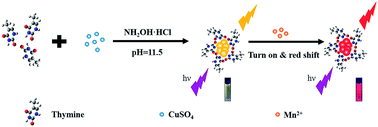One-step rapid synthesis of single thymine-templated fluorescent copper nanoclusters for “turn on” detection of Mn2+†
Abstract
Rich-thymine (T) single- or double-strand DNAs have been identified as efficient templates favoring the formation of fluorescent copper nanoparticles (Cu NPs). In this work, we confirmed single base T could be a template to synthesize water-soluble copper nanoclusters (Cu NCs@T) for the first time. Our work provided basic evidence of the benefit of using T-rich DNA strands for the synthesis of fluorescent Cu NPs. Transmission electron microscopy demonstrated that Cu NCs@T had a diameter of 2.8 ± 0.5 nm, which is much smaller than Cu NPs templated by single- or double-strand DNAs. X-ray photoelectron spectroscopy confirmed the valence state of the Cu in Cu NCs@T most likely lies between 0 and +1. The as-prepared Cu NCs@T exhibited yellow photoluminescence and the maximum excitation and emission peaks were at 354 nm and 561 nm, respectively. In addition, we also showed that the as-prepared Cu NCs@T can be developed into a practical sensor for “turn-on” luminescence with the emission red-shifted detection of Mn2+ in aqueous solution with a high selectivity. The limit of detection for Mn2+ was determined to be 10 μM and the linear response with the Mn2+ concentrations range from 100 μM to 250 μM.



 Please wait while we load your content...
Please wait while we load your content...